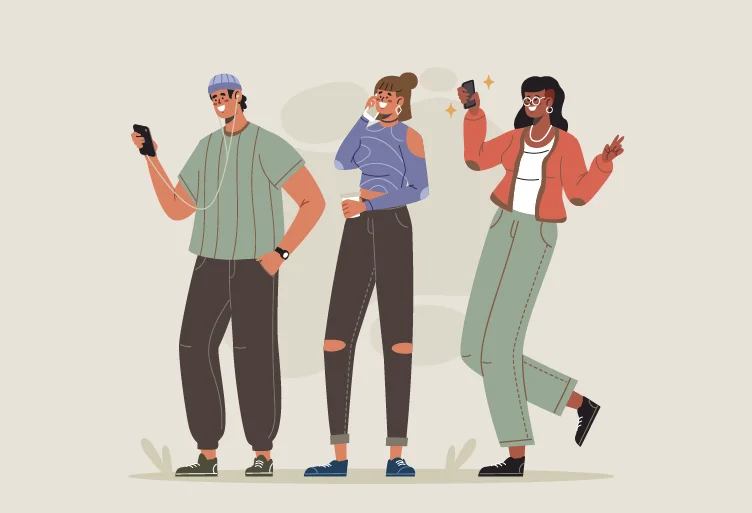Understanding Multimodal Learning
Multimodal learning has gained traction as educators and researchers recognize its potential to enhance the educational experience.
Definition and Importance of Multimodal Learning
Multimodal learning stands for using multiple modes or channels of information presentation in teaching. By integrating visual, auditory, kinesthetic, and textual methods, educators cater to diverse learning preferences, ensuring a more comprehensive understanding for students.
This approach recognizes that learners differ in how they best absorb and process information, and it optimizes their chances of retaining and applying knowledge.
Advantages of Incorporating Multimodal Learning
Multimodal learning isn’t just a contemporary educational buzzword; it’s a transformative approach that brings numerous advantages to educators and learners.
Here’s a deep dive into the benefits:
- Catering to Diverse Learning Styles: Everyone has a unique way of processing information. While some might find visual aids most effective, others might rely on auditory or kinesthetic cues. Multimodal learning ensures that content is presented in varied formats, thus addressing the needs of all learners.
- Enhanced Retention and Comprehension: Learners who engage with content across multiple modes are more likely to retain and comprehend it. By leveraging different sensory channels, information is processed more deeply, leading to better understanding. A recent study from ResearchGate revealed that 72.6% of learners favored learning through various sensory methods.
- Increased Engagement: Introducing diverse media and teaching techniques can make lessons more engaging and interactive. Students are less likely to lose interest when actively participating in their learning process.
- Flexibility in Learning: Multimodal instructional strategies allow learners to choose the mode that suits them best. This empowers them to take control of their learning journey, allowing for personalized experiences.
- Preparation for Real-world Challenges: By exposing learners to multimodal learning, they are better equipped to handle diverse challenges, as they are accustomed to processing information from various sources.
- Promotion of Critical Thinking: Engaging with content across different modes encourages learners to compare, contrast, and draw connections, fostering critical thinking and analytical skills.
Incorporating multimodal learning strategies in education is a move towards a more inclusive, engaging, and effective learning environment. It recognizes the multifaceted nature of human cognition and capitalizes on it to provide a comprehensive educational experience.
Core Types of Multimodal Learning
The beauty of multimodal learning lies in its adaptability to diverse learners. As we delve deeper into its essence, it’s crucial to understand the core types that form its foundation. Each mode offers unique pathways to engagement and comprehension, ensuring every student finds resonance.
Visual Learning: Engaging through Sight
Visual learners thrive when they can see and observe. Diagrams, charts, videos, and infographics become essential tools for these learners. Visual representation allows them to easily understand, retain, and recall complex concepts.
Auditory Learning: Immersive Sound Strategies
Auditory learning is the way forward for those who grasp information best when they hear it. Sound becomes an instrumental aid through lectures, podcasts, or musical rhythms. Engaging auditory learners means ensuring the auditory presentation is clear, varied, and memorable.
Kinesthetic Learning: The Power of Physical Tasks
Kinesthetic learners learn best when they move. Hands-on activities, role-playing, and tactile experiences are their pathways to understanding. For these learners, doing is understanding, and educators can leverage physical tasks to enhance their learning journey.
Reading/Writing Preferences: Literacy in Learning
Some learners prefer the traditional approach of reading and writing. They benefit immensely from text-based resources, journaling, essays, and reports. Ensuring a wealth of textual materials and writing opportunities can significantly elevate their educational experience.
Recognizing and harnessing these core types of multimodal learning paves the way for a more inclusive and adaptive educational landscape, ensuring that every student’s learning preference is addressed and celebrated.
Innovative Strategies for Effective Multimodal Learning
The importance of multimodal learning lies in understanding its core types and applying inventive strategies that optimize its benefits. As the educational landscape continually evolves, embracing innovative approaches can make a difference in crafting impactful learning experiences. Let’s delve into some of these pioneering strategies.
Enhancing Emotional Resonance and Classroom Environment
The best learning outcomes are often achieved in physically comfortable and emotionally resonant environments. An environment that speaks to the learner’s emotions aids deeper retention and comprehension.
In addition to having ergonomic chairs and well-lit rooms, it’s also about creating an atmosphere where learners feel a personal connection. Elements like mood lighting, compelling visuals, ambient background music, and tactile materials can set the tone for an inclusive learning experience. These elements, when combined, craft an ambiance that resonates with different learner types, creating a space where everyone feels they belong.
Laying the Groundwork for Advanced Literacy Development
Literacy in the 21st century has evolved to encompass more than just traditional reading and writing. It’s about developing proficiency across diverse media forms. Students are expected to read, write, interpret, analyze, and create content across various platforms.
Students can hone these skills by encouraging interactive activities such as group discussions, debates, and multimedia projects, making them adept at navigating the vast information landscape.
Integrating Diverse Media Elements in Lessons
We live in a golden age of technological advancements, and education has greatly benefited. Recent data from Pew Research indicates that as many as 95% of teenagers possess a smartphone.
With tools ranging from interactive videos, podcasts, and digital simulations to the immersive experiences offered by augmented reality, educators have a treasure trove of resources at their disposal.
Educators can ensure each session caters to different learning styles by judiciously integrating these tools into lessons. Such an approach not only makes lessons more engaging but also ensures that they are comprehensive and holistic.
Blended Learning Techniques for a Holistic Approach
While digital tools offer innovative methods to impart knowledge, the importance of traditional face-to-face interactions must be maintained. Blended learning combines the best of both worlds. It allows learners to engage with content online at their own pace while benefiting from real-time interactions and discussions. This multimodal instructional strategy ensures learners have a rounded experience, making the learning process flexible and personal.
When these strategies are integrated into the curriculum, they have the potential to revolutionize the way we approach education. They ensure that learning becomes vibrant, dynamic, engaging, and effective.
Practical Implementation of Multimodal Learning
The theoretical understanding of multimodal learning is essential, but its real power is unleashed when put into practice. Practical implementation can be the bridge that connects abstract concepts to tangible results, ensuring learners not only understand but also apply their knowledge. Let’s explore some actionable steps educators can take to bring multimodal learning to life in their classrooms.
Designing Multimodal Assignments for Enhanced Engagement
The age-old approach of assigning written essays or reading tasks is evolving. Instead, consider assignments that allow students to showcase their understanding through various modes. This could mean creating a video presentation, designing an infographic, recording a podcast, or staging a short skit. Such assignments encourage creativity, cater to different learning preferences, and are likely to increase student involvement and enthusiasm.
Diversifying Feedback Mechanisms through Your LMS
Learning Management Systems (LMS) have become a mainstay in modern education, offering tools that can greatly enhance the multimodal experience. Instead of the traditional written feedback, educators can use the LMS to provide auditory feedback, video comments, or even interactive quizzes. This ensures that the feedback process, a critical learning component, also aligns with diverse learning preferences.
Encouraging Interactive and Collaborative Learning Experiences
The essence of multimodal learning lies in its interactive nature. Encouraging students to work collaboratively on projects can boost this interactivity. Group projects, peer reviews, and class discussions allow students to share, debate, and learn from diverse perspectives.
Collaborative tools, both online and offline, can be harnessed to facilitate such interactions, ensuring students engage deeply with content and peers.
The expedition of a multimodal approach to teaching is not about discarding old methods but enhancing them. By integrating innovative approaches and strategies, educators can ensure that their teaching is heard, seen, and experienced in myriad ways by every learner.
Maximizing the Benefits of Multimodal Learning
Multimodal learning offers unparalleled educational advantages with its rich tapestry of methods. However, to fully harness its potential, educators must proactively address challenges and ensure continuous refinement of their teaching approaches. In this section, we’ll delve into ways to optimize the outcomes of multimodal learning.
Evaluating the Effectiveness of Multimodal Strategies
The first step towards maximizing benefits is understanding what’s working and what’s not. Regular evaluations and assessments can provide insights into the effectiveness of the deployed multimodal learning strategies.
This involves gathering student feedback, analyzing performance metrics, and assessing engagement levels. Surveys, quizzes, focus group discussions, and digital analytics from Learning Management Systems (LMS) can be invaluable tools in this evaluation process.
Overcoming Challenges in Multimodal Learning Implementation
While multimodal learning is compelling, its implementation can present challenges. Some students initially resist unfamiliar teaching methods, and educators might need help with the technical aspects of new tools. Addressing these challenges requires a combination of training, patience, and flexibility.
For example, educators can attend workshops to enhance their digital literacy, while students can be gradually introduced to new methods, ensuring a smoother transition.
Continuous Improvement and Adaptation in Teaching Methods
Continuous improvement is the cornerstone of effective teaching. This means regularly updating course materials, integrating the latest tools and technologies, and adapting to feedback.
Encourage open communication where students feel comfortable sharing their preferences and challenges. This two-way dialogue can pave the way for a more tailored and effective multimodal learning experience.
With careful evaluation, proactive problem-solving, and a commitment to continuous growth, educators can ensure their students receive an engaging, holistic, and effective learning experience.
Conclusion: The Future of Learning with Multimodal Strategies
Navigating the evolving educational landscape requires innovative approaches. Multimodal learning is a beacon, promising more inclusive and adaptive education for diverse learners. Undoubtedly, the shift from traditional methods to dynamic, student-centric approaches is evident. To thrive, educators need flexibility, continuous learning, and a willingness to adapt to changing paradigms.
The rise of VR, AR, AI, and other digital tools is reshaping education. By blending these technologies with foundational teaching practices, we can craft richer, more engaging learning experiences. The future holds a holistic educational approach where technology and tradition intertwine, ensuring every learner feels seen, heard, and inspired.
- Understanding Multimodal Learning Multimodal learning has gained traction as educators and researchers recognize its potential to enhance the educational experience. Definition and Importance of Multimodal Learning Multimodal learning stands for using multiple modes or channels of information presentation in teaching. By integrating visual, auditory, kinesthetic, and textual methods, educators cater to diverse learning preferences, ensuring a more comprehensive understanding for students. This approach recognizes that learners differ in how they best absorb and process information, and it optimizes their chances of retaining and applying knowledge. Advantages of Incorporating Multimodal Learning Multimodal learning isn't just a contemporary educational buzzword; it's a transformative approach that brings numerous advantages to educators and learners. Here's a deep dive into the benefits: Catering to Diverse Learning Styles: Everyone has a unique way of processing information. While some might find visual aids most effective, others might rely on auditory or kinesthetic cues. Multimodal learning ensures that content is presented in varied formats, thus addressing the needs of all learners. Enhanced Retention and Comprehension: Learners who engage with content across multiple modes are more likely to retain and comprehend it. By leveraging different sensory channels, information is processed more deeply, leading to better understanding. A recent study from ResearchGate revealed that 72.6% of learners favored learning through various sensory methods. Increased Engagement: Introducing diverse media and teaching techniques can make lessons more engaging and interactive. Students are less likely to lose interest when actively participating in their learning process. Flexibility in Learning: Multimodal instructional strategies allow learners to choose the mode that suits them best. This empowers them to take control of their learning journey, allowing for personalized experiences. Preparation for Real-world Challenges: By exposing learners to multimodal learning, they are better equipped to handle diverse challenges, as they are accustomed to processing information from various sources. Promotion of Critical Thinking: Engaging with content across different modes encourages learners to compare, contrast, and draw connections, fostering critical thinking and analytical skills. Incorporating multimodal learning strategies in education is a move towards a more inclusive, engaging, and effective learning environment. It recognizes the multifaceted nature of human cognition and capitalizes on it to provide a comprehensive educational experience. Core Types of Multimodal Learning The beauty of multimodal learning lies in its adaptability to diverse learners. As we delve deeper into its essence, it's crucial to understand the core types that form its foundation. Each mode offers unique pathways to engagement and comprehension, ensuring every student finds resonance. Visual Learning: Engaging through Sight Visual learners thrive when they can see and observe. Diagrams, charts, videos, and infographics become essential tools for these learners. Visual representation allows them to easily understand, retain, and recall complex concepts. Auditory Learning: Immersive Sound Strategies Auditory learning is the way forward for those who grasp information best when they hear it. Sound becomes an instrumental aid through lectures, podcasts, or musical rhythms. Engaging auditory learners means ensuring the auditory presentation is clear, varied, and memorable. Kinesthetic Learning: The Power of Physical Tasks Kinesthetic learners learn best when they move. Hands-on activities, role-playing, and tactile experiences are their pathways to understanding. For these learners, doing is understanding, and educators can leverage physical tasks to enhance their learning journey. Reading/Writing Preferences: Literacy in Learning Some learners prefer the traditional approach of reading and writing. They benefit immensely from text-based resources, journaling, essays, and reports. Ensuring a wealth of textual materials and writing opportunities can significantly elevate their educational experience. Recognizing and harnessing these core types of multimodal learning paves the way for a more inclusive and adaptive educational landscape, ensuring that every student's learning preference is addressed and celebrated. Innovative Strategies for Effective Multimodal Learning The importance of multimodal learning lies in understanding its core types and applying inventive strategies that optimize its benefits. As the educational landscape continually evolves, embracing innovative approaches can make a difference in crafting impactful learning experiences. Let’s delve into some of these pioneering strategies. Enhancing Emotional Resonance and Classroom Environment The best learning outcomes are often achieved in physically comfortable and emotionally resonant environments. An environment that speaks to the learner's emotions aids deeper retention and comprehension. In addition to having ergonomic chairs and well-lit rooms, it's also about creating an atmosphere where learners feel a personal connection. Elements like mood lighting, compelling visuals, ambient background music, and tactile materials can set the tone for an inclusive learning experience. These elements, when combined, craft an ambiance that resonates with different learner types, creating a space where everyone feels they belong. Laying the Groundwork for Advanced Literacy Development Literacy in the 21st century has evolved to encompass more than just traditional reading and writing. It's about developing proficiency across diverse media forms. Students are expected to read, write, interpret, analyze, and create content across various platforms. Students can hone these skills by encouraging interactive activities such as group discussions, debates, and multimedia projects, making them adept at navigating the vast information landscape. Integrating Diverse Media Elements in Lessons We live in a golden age of technological advancements, and education has greatly benefited. Recent data from Pew Research indicates that as many as 95% of teenagers possess a smartphone. With tools ranging from interactive videos, podcasts, and digital simulations to the immersive experiences offered by augmented reality, educators have a treasure trove of resources at their disposal. Educators can ensure each session caters to different learning styles by judiciously integrating these tools into lessons. Such an approach not only makes lessons more engaging but also ensures that they are comprehensive and holistic. Blended Learning Techniques for a Holistic Approach While digital tools offer innovative methods to impart knowledge, the importance of traditional face-to-face interactions must be maintained. Blended learning combines the best of both worlds. It allows learners to engage with content online at their own pace while benefiting from real-time interactions and discussions. This multimodal instructional strategy ensures learners have a rounded experience, making the learning process flexible and personal. When these strategies are integrated into the curriculum, they have the potential to revolutionize the way we approach education. They ensure that learning becomes vibrant, dynamic, engaging, and effective. Practical Implementation of Multimodal Learning The theoretical understanding of multimodal learning is essential, but its real power is unleashed when put into practice. Practical implementation can be the bridge that connects abstract concepts to tangible results, ensuring learners not only understand but also apply their knowledge. Let's explore some actionable steps educators can take to bring multimodal learning to life in their classrooms. Designing Multimodal Assignments for Enhanced Engagement The age-old approach of assigning written essays or reading tasks is evolving. Instead, consider assignments that allow students to showcase their understanding through various modes. This could mean creating a video presentation, designing an infographic, recording a podcast, or staging a short skit. Such assignments encourage creativity, cater to different learning preferences, and are likely to increase student involvement and enthusiasm. Diversifying Feedback Mechanisms through Your LMSLearning Management Systems (LMS) have become a mainstay in modern education, offering tools that can greatly enhance the multimodal experience. Instead of the traditional written feedback, educators can use the LMS to provide auditory feedback, video comments, or even interactive quizzes. This ensures that the feedback process, a critical learning component, also aligns with diverse learning preferences. Encouraging Interactive and Collaborative Learning Experiences The essence of multimodal learning lies in its interactive nature. Encouraging students to work collaboratively on projects can boost this interactivity. Group projects, peer reviews, and class discussions allow students to share, debate, and learn from diverse perspectives. Collaborative tools, both online and offline, can be harnessed to facilitate such interactions, ensuring students engage deeply with content and peers. The expedition of a multimodal approach to teaching is not about discarding old methods but enhancing them. By integrating innovative approaches and strategies, educators can ensure that their teaching is heard, seen, and experienced in myriad ways by every learner. Maximizing the Benefits of Multimodal Learning Multimodal learning offers unparalleled educational advantages with its rich tapestry of methods. However, to fully harness its potential, educators must proactively address challenges and ensure continuous refinement of their teaching approaches. In this section, we'll delve into ways to optimize the outcomes of multimodal learning. Evaluating the Effectiveness of Multimodal Strategies The first step towards maximizing benefits is understanding what’s working and what’s not. Regular evaluations and assessments can provide insights into the effectiveness of the deployed multimodal learning strategies. This involves gathering student feedback, analyzing performance metrics, and assessing engagement levels. Surveys, quizzes, focus group discussions, and digital analytics from Learning Management Systems (LMS) can be invaluable tools in this evaluation process. Overcoming Challenges in Multimodal Learning Implementation While multimodal learning is compelling, its implementation can present challenges. Some students initially resist unfamiliar teaching methods, and educators might need help with the technical aspects of new tools. Addressing these challenges requires a combination of training, patience, and flexibility. For example, educators can attend workshops to enhance their digital literacy, while students can be gradually introduced to new methods, ensuring a smoother transition. Continuous Improvement and Adaptation in Teaching Methods Continuous improvement is the cornerstone of effective teaching. This means regularly updating course materials, integrating the latest tools and technologies, and adapting to feedback. Encourage open communication where students feel comfortable sharing their preferences and challenges. This two-way dialogue can pave the way for a more tailored and effective multimodal learning experience. With careful evaluation, proactive problem-solving, and a commitment to continuous growth, educators can ensure their students receive an engaging, holistic, and effective learning experience. Conclusion: The Future of Learning with Multimodal Strategies Navigating the evolving educational landscape requires innovative approaches. Multimodal learning is a beacon, promising more inclusive and adaptive education for diverse learners. Undoubtedly, the shift from traditional methods to dynamic, student-centric approaches is evident. To thrive, educators need flexibility, continuous learning, and a willingness to adapt to changing paradigms. The rise of VR, AR, AI, and other digital tools is reshaping education. By blending these technologies with foundational teaching practices, we can craft richer, more engaging learning experiences. The future holds a holistic educational approach where technology and tradition intertwine, ensuring every learner feels seen, heard, and inspired.
- Core Types of Multimodal Learning
- Innovative Strategies for Effective Multimodal Learning
- Practical Implementation of Multimodal Learning
- Maximizing the Benefits of Multimodal Learning
- Conclusion: The Future of Learning with Multimodal Strategies







